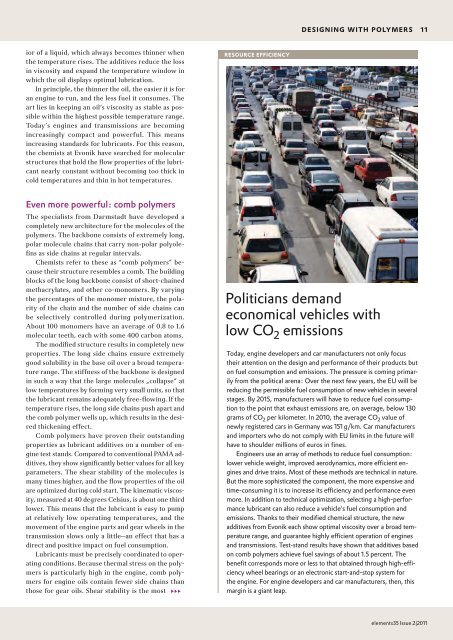Download - Evonik Industries
Download - Evonik Industries
Download - Evonik Industries
Create successful ePaper yourself
Turn your PDF publications into a flip-book with our unique Google optimized e-Paper software.
ior of a liquid, which always becomes thinner when<br />
the temperature rises. The additives reduce the loss<br />
in viscosity and expand the temperature window in<br />
which the oil displays optimal lubrication.<br />
In principle, the thinner the oil, the easier it is for<br />
an engine to run, and the less fuel it consumes. The<br />
art lies in keeping an oil‘s viscosity as stable as possible<br />
within the highest possible temperature range.<br />
Today’s engines and transmissions are becoming<br />
increasingly compact and powerful. This means<br />
increasing standards for lubricants. For this reason,<br />
the chemists at <strong>Evonik</strong> have searched for molecular<br />
structures that hold the flow properties of the lubricant<br />
nearly constant without becoming too thick in<br />
cold temperatures and thin in hot temperatures.<br />
Even more powerful: comb polymers<br />
The specialists from Darmstadt have developed a<br />
completely new architecture for the molecules of the<br />
polymers. The backbone consists of extremely long,<br />
polar molecule chains that carry non-polar polyolefins<br />
as side chains at regular intervals.<br />
Chemists refer to these as “comb polymers” because<br />
their structure resembles a comb. The building<br />
blocks of the long backbone consist of short-chained<br />
methacrylates, and other co-monomers. By varying<br />
the percentages of the monomer mixture, the polarity<br />
of the chain and the number of side chains can<br />
be selectively controlled during polymerization.<br />
About 100 monomers have an aver age of 0.8 to 1.6<br />
molecular teeth, each with some 400 carbon atoms.<br />
The modified structure results in completely new<br />
properties. The long side chains ensure extremely<br />
good solubility in the base oil over a broad temperature<br />
range. The stiffness of the backbone is designed<br />
in such a way that the large molecules „collapse“ at<br />
low temperatures by forming very small units, so that<br />
the lubricant remains adequately free-flowing. If the<br />
temperature rises, the long side chains push apart and<br />
the comb polymer wells up, which results in the desired<br />
thickening effect.<br />
Comb polymers have proven their outstanding<br />
properties as lubricant additives on a number of engine<br />
test stands. Compared to conventional PAMA additives,<br />
they show significantly better values for all key<br />
parameters. The shear stability of the molecules is<br />
many times higher, and the flow properties of the oil<br />
are optimized during cold start. The kinematic viscosity,<br />
measured at 40 degrees Celsius, is about one third<br />
lower. This means that the lubricant is easy to pump<br />
at relatively low operating temperatures, and the<br />
movement of the engine parts and gear wheels in the<br />
transmission slows only a little—an effect that has a<br />
direct and positive impact on fuel consumption.<br />
Lubricants must be precisely coordinated to operating<br />
conditions. Because thermal stress on the polymers<br />
is particularly high in the engine, comb polymers<br />
for engine oils contain fewer side chains than<br />
those for gear oils. Shear stability is the most 333<br />
ResouRCe effICIenCY<br />
DesIGnInG WItH PoLYMeRs 11<br />
Politicians demand<br />
economical vehicles with<br />
low CO 2 emissions<br />
Today, engine developers and car manufacturers not only focus<br />
their attention on the design and performance of their products but<br />
on fuel consumption and emissions. The pressure is coming primarily<br />
from the political arena: Over the next few years, the EU will be<br />
reducing the permissible fuel consumption of new vehicles in several<br />
stages. By 2015, manufacturers will have to reduce fuel consumption<br />
to the point that exhaust emissions are, on average, below 130<br />
grams of CO 2 per kilometer. In 2010, the average CO 2 value of<br />
newly registered cars in Germany was 151 g/km. Car manufacturers<br />
and importers who do not comply with EU limits in the future will<br />
have to shoulder millions of euros in fines.<br />
Engineers use an array of methods to reduce fuel consumption:<br />
lower vehicle weight, improved aerodynamics, more efficient engines<br />
and drive trains. Most of these methods are technical in nature.<br />
But the more sophisticated the component, the more expensive and<br />
time-consuming it is to increase its efficiency and performance even<br />
more. In addition to technical optimization, selecting a high-performance<br />
lubricant can also reduce a vehicle‘s fuel consumption and<br />
emissions. Thanks to their modified chemical structure, the new<br />
additives from <strong>Evonik</strong> each show optimal viscosity over a broad temperature<br />
range, and guarantee highly efficient operation of engines<br />
and transmissions. Test-stand results have shown that additives based<br />
on comb polymers achieve fuel savings of about 1.5 percent. The<br />
benefit corresponds more or less to that obtained through high-efficiency<br />
wheel bearings or an electronic start-and-stop system for<br />
the engine. For engine developers and car manu facturers, then, this<br />
margin is a giant leap.<br />
elements35 Issue 2|2011
















